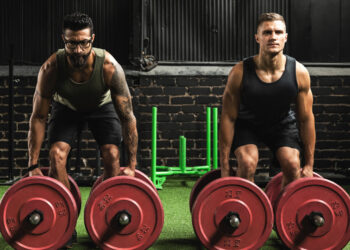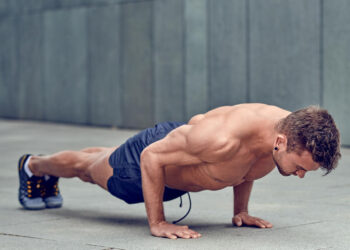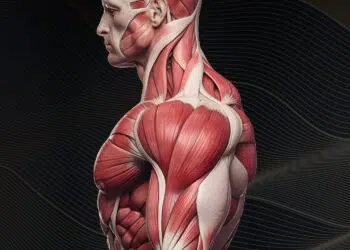The pull-up is one of the most impressive (read: badass) exercises. You need incredible upper body strength and coordination to perform a pull-up. If you think bodyweight exercises are easy, pull-ups will make you reconsider this assumption.
Beginners usually require eight to 12 weeks to complete their first unassisted pull-up. On the other hand, most professional bodybuilders can only perform 8–12 bodyweight pull-ups, just enough to ignite hypertrophy. (1)
Broad shoulders, a tapering back, and a tiny waist characterize an aesthetically appealing physique. Vertical pulling exercises, like the pull-up, get you close to this objective by biasing the latissimus dorsi, the largest upper back muscle.
In this article, we go over everything you need to know about pull-ups, including the step-by-step instructions, their benefits, muscles worked, common mistakes, alternatives, and the most effective progression exercises.
What is a Pull-Up?
The pull-up is an excellent compound exercise that trains multiple muscle groups. It primarily builds muscle and strength in the back muscles. The biceps, forearms, shoulders, and abs are the secondary movers.
Since this exercise involves multiple muscles, it improves overall functionality, boosting your physical performance in daily activities. It can also enhance your output in sports that require upper body strength, such as basketball, hockey, and cricket.
Level Up Your Fitness: Join our 💪 strong community in Fitness Volt Newsletter. Get daily inspiration, expert-backed workouts, nutrition tips, the latest in strength sports, and the support you need to reach your goals. Subscribe for free!
You only need a sturdy elevated bar to perform pull-ups, making this exercise incredibly accessible. Whether you workout at a high-end training facility or in your basement gym, you can add pull-ups to your training regime. It’s best to do the pull-up at the beginning of a workout since a lot of energy and strength are required to perform sufficient sets and reps.
How To Do a Pull-Up
This is the step-by-step guide to performing the pull-up:
Step One — Setup
Stand under a pull-up bar that is high enough that your feet don’t touch the ground during the exercise. Jump and grab the pull-up bar with a shoulder-wide overhand grip. Your body should be in a straight line at the starting position.
Pro Tip: Beginners should stand on an elevated platform like an aerobic step to grab the bar, as it will allow you to get a better grip on it.
Step Two — Ascent
Take a deep breath, brace your core, and raise your upper chest to the pull-up bar by driving your elbows down and into your sides. Focus on pulling your scapula together and driving your elbows behind your midline. Arch your back slightly during the concentric phase to maximize upper back stimulation.
Your chin should be above the bar at the top of the range of motion. Squeeze your lats in the shortened position.
Pro Tip: Avoid swinging your legs to generate momentum; it takes tension off your lats and puts it on your secondary muscle groups and joints.
Step Three — Descent
Breathe out and return to the starting position using a slow and controlled motion. Avoid locking out your elbows at the bottom of the range of motion to maintain constant tension on your lats. Repeat for recommended reps.
Pro Tip: Eccentrics are often overlooked during pull-ups. However, they hold incredible muscle-building potential. According to a British Journal of Sports Medicine study, “Eccentric training performed at high intensities was shown to be more effective in promoting increases in muscle mass measured as muscle girth.” (2)
Pull-Up Tips:
- Beginners should perform pull-ups using a full grip. A false (thumbless) grip makes it more challenging to hold onto the bar, which can hamper your performance. Conversely, advanced exercisers can use a thumbless grip to limit forearm engagement.
- Switch your grips (overhand, underhand, or neutral) to target your back from different angles and ensure overall development.
- Beginners should stack their ankles and bend their legs so their lower legs are parallel to the floor. This makes the exercise a little easier.
- Folks that can only perform 1–5 pull-ups should spend as long as possible on the eccentric phase. It will help build strength and muscle mass.
- Use lifting straps if your grip is the limiting factor in this exercise.
Muscles Worked During Pull-Ups
The pull-up works the following muscles:
Back
The back is the primary target muscle group in the pull-up. While the latissimus dorsi, popularly known as the lats, receive most of the stimulation, it also engages other upper body muscles like the traps, rhomboids, and teres major and minor.
Arms
Since pull-ups involve elbow flexion and extension, you cannot eliminate biceps and triceps engagement in this exercise. Your biceps will kick in during the concentric phase. However, you can limit your triceps engagement by avoiding locking out your elbows at the bottom of the range of motion.
Shoulders
Pull-ups also involve movement at the shoulder joint, resulting in the engagement of all three shoulder heads — anterior, lateral, and posterior. The anterior delts do most of the work on concentrics, and the rear delts take over during the lowering phase.
Abs
The role of the core is often overlooked while performing pull-ups. Your core, including the abs, glutes, and obliques, play a vital role in keeping your torso stable during the exercise. Perform a high-rep pull-up set to experience ab stimulation.
Benefits of Pull-Ups
Adding the pull-up to your training regimen entails the following advantages:
Build Upper Body Strength and Muscle Mass
Perform three to five sets of eight to 12 reps of bodyweight pull-ups to bias hypertrophy. On the flip side, exercisers prioritizing strength gains should do three to six sets of one to five reps with additional weights. (1)
Improves Functionality
Pull-ups involve moving your shoulder and elbow joints through an extended range of motion. Plus, it can enhance your mobility over time and build core strength, leading to better performance in daily chores.
Coordination
Pull-ups involve several moving parts, which can improve your hand-eye coordination. This enhanced coordination can carry over to other compound exercises like shoulder presses, snatch, and clean & jerk.
Boost Self-Confidence
The ability to perform a bodyweight pull-up can boost your confidence and improve your self-image. It will also set you up for trying more challenging exercises like the front lever and L-sit.
Common Mistakes While Performing Pull-Ups
Avoid the following pull-up mistakes to get the best bang for your buck and limit your risk of injury:
Level Up Your Fitness: Join our 💪 strong community in Fitness Volt Newsletter. Get daily inspiration, expert-backed workouts, nutrition tips, the latest in strength sports, and the support you need to reach your goals. Subscribe for free!
Confusing Pull-Ups with Chin-Ups
Many people use pull-ups and chin-ups interchangeably. They, however, are not the same exercise. Pull-ups involve a shoulder-wide overhand grip, whereas chin-ups involve an underhand grip. The former primarily targets the lats, whereas the latter results in significant biceps recruitment.
Using Momentum
Bodybuilders training for muscle gains should limit the movement to their shoulder and elbow joints and follow a strict range of motion to keep the tension on the lats. Swinging your legs to generate momentum takes the tension off your back and puts it on your secondary muscles.
That said, CrossFitters or gymnasts can use a kip to move more flawlessly between Point A and Point B. You must keep your training objective in mind while performing an exercise.
Following a Limited Range of Motion
Most lifters never get their chin over the bar and stop the descent when their upper arms are parallel to the floor. Following a restricted range of motion will limit your muscle engagement and, hence, hypertrophy. Conversely, following a limited range of motion in CrossFit leads to a no-rep, which is a total waste of time and effort.
Pull-Up Progression
The pull-up is usually unsuitable for beginners as you need significant upper body strength to pull your chin to the bar. Conversely, most people go overboard with the progression exercises and do complicated exercises that don’t contribute much to their progress.
Here are a few simple pull-up progression exercises that you can do to build the requisite strength for the pull-up.
Assisted Pull-Up Machine
Most commercial gyms have assisted pull-up machines to get you to your first bodyweight pull-up. Beginners can start on the assisted pull-up machine with the full stack engaged. However, you must ensure that you are taking a few plates off the stack in every training session. This progressive overload will help you transition to your first bodyweight pull-up.
That said, many pro bodybuilders also use the assisted pull-up machine to eliminate the possibility of using momentum and keep the tension on the lats.
Negatives
Eccentrics are an excellent way to build the strength required for a bodyweight pull-up. There are three ways of doing negative-only pull-ups. First, stand under a pull-up, jump, and grab the bar. Take as long as possible to return to the starting position.
Folks who perform pull-ups in a squat rack can adjust the side rails and stand on them so their chin is at the bar level at the starting position. Alternatively, you could ask your training partner for a boost and lower slowly. Remember, you must reset after every rep. You don’t want to expend effort on the concentric phase in this pull-up progression exercise.
Banded Pull-Ups
Banded pull-ups work like the assisted pull-up machine and are perfect for people who train at a bare-bone gym. In this pull-up progression exercise, you wrap one end of the resistance band around the pull-up bar and the other end around one or both of your feet.
The band should be hard enough to support your body weight and thrust you toward the pull-up bar. This pull-up progression can take some time getting used to. However, it is worth it as you can use it while learning more advanced exercises like the muscle-up.
Alternatives of Pull-Up
Use the following pull-up alternatives to build a wide and thick back:
Lat Pulldown
The lat pulldown is the closest alternative to the pull-up. It targets the same muscle groups and uses a cable mechanism, which keeps constant tension on your lats throughout the ROM.
Steps:
- Grab the bar with a slightly wider-than-shoulder-width overhand grip.
- Secure your upper legs under the lat pulldown machine’s thigh pads.
- Keeping your torso upright, pull the bar to your upper chest while driving through your elbows.
- Pause and squeeze your lats at the isometric contraction point at the bottom.
- Return to the starting position.
Pro Tip: Avoid leaning back during concentrics, as it removes tension from your lats and puts it on your rear deltoids and trapezius muscles.
Dumbbell Pullover
This pull-up alternative helps build a V-taper. It was a staple in Arnold Schwarzenegger’s back training routine; there is no reason why it shouldn’t be in yours.
Steps:
- Lie across a flat bench with your upper back and shoulders on it.
- Your feet should be shoulder-width apart.
- Hold a dumbbell over your chest by cupping your hands under its top end.
- Keeping your hips close to the ground, lift the dumbbell toward the ceiling and down to the floor behind your head in one sweeping motion.
- Reverse the motion to return to the starting position.
Pro Tip: Use a moderate-weight dumbbell while performing this exercise. Going too heavy can lead to shoulder and triceps engagement.
Bent-Over Barbell Row
The bent-over barbell row is an incredibly effective exercise to build a thick and girthy back.
Steps:
- Stand upright with a hip-width stance while holding a barbell with a shoulder-wide overhand grip.
- Bend your knees slightly and hinge at your hips so your torso is at 45 degrees.
- Arch your back slightly to bias your lats. The bar should be below your knees at the starting position.
- Pull the barbell to your belly button while keeping your elbows tight to your torso.
- Pause and contract your lats at the top.
- Slowly return to the starting position.
Pro Tip: Switch to an underhand grip to target the lower lats. It will, however, lead to greater biceps engagement.
FAQs
How long will it take to perform my first bodyweight pull-up?
It will depend on your starting physique and training schedule. Most beginners need eight to 12 weeks before they can perform their first bodyweight pull-up. Exercisers that practice this movement daily might get to the objective faster.
Should beginners perform pull-up progression exercises or limit themselves to bodyweight pull-ups?
Using progression exercise can help you get to your first bodyweight pull-up faster. However, you must stick to a few progression exercises and practice them at least thrice a week. Sticking to the conventional pull-up will also get you to your objective, but it might take longer.
Can I substitute the pull-up with lat pulldowns in my training regimen?
Many lifters replace pull-ups with lat pulldowns in their training regimen. Although they contest that bodyweight exercises aren’t as effective for building muscle as those involving additional weights, the real reason behind the switch is that pull-ups are more challenging.
That said, you shouldn’t replace one exercise with the other in your training regimen. Both movements should be a part of your workout program to ensure overall back development.
Wrapping Up
The pull-up is one of the best exercises to build upper body strength and functionality. It is one of the foundational exercises in calisthenics, and mastering the pull-up can unlock many advanced bar exercises like the typewriter pull-ups and muscle-ups.
Exercisers training for hypertrophy should use a strict form on the pull-up, whereas people training for functionality can use momentum. Do the pull-up at the beginning of your back workout or as a superset in the middle to annihilate your lats. Or you could go the Arnold way and use it as a warm-up exercise before any upper-body training session. Best of luck!
References
- Schoenfeld BJ, Grgic J, Van Every DW, Plotkin DL. Loading Recommendations for Muscle Strength, Hypertrophy, and Local Endurance: A Re-Examination of the Repetition Continuum. Sports (Basel). 2021 Feb 22;9(2):32. doi: 10.3390/sports9020032. PMID: 33671664; PMCID: PMC7927075.
- Roig M, O’Brien K, Kirk G, Murray R, McKinnon P, Shadgan B, Reid WD. The effects of eccentric versus concentric resistance training on muscle strength and mass in healthy adults: a systematic review with meta-analysis. Br J Sports Med. 2009 Aug;43(8):556-68. doi: 10.1136/bjsm.2008.051417. Epub 2008 Nov 3. PMID: 18981046.
Interested in measuring your progress? Check out our strength standards for Dumbbell Pullover, Muscle Ups, Pull Ups, and more.








